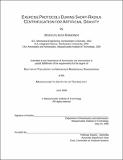Exercise protocols during short-radius centrifugation for artificial gravity
Author(s)
Edmonds, Jessica Leigh
DownloadFull printable version (7.286Mb)
Other Contributors
Massachusetts Institute of Technology. Dept. of Aeronautics and Astronautics.
Advisor
Laurence R. Young.
Terms of use
Metadata
Show full item recordAbstract
Long-duration spaceflight results in severe physiological deconditioning, threatening the success of interplanetary travel. Exercise combined with artificial gravity provided by centrifugation may be the comprehensive countermeasure needed to prevent such deconditioning. The aims of this study were (1) to characterize the physiological responses to longitudinal g-gradient and high g-levels during short-radius centrifugation, and (2) to quantify the fitness benefits of an eight-week exercise program on a short-radius centrifuge. In the first experiment, we utilized a tilting short-radius centrifuge to investigate heart rate, blood pressure, and calf volume responses to high g-level and g-gradient centrifugation with and without light exercise (stepping in place). All measures increased significantly with increasing g-level and increasing g-gradient, but these effects were reduced significantly when the subject stepped in place. In the second experiment, we quantified the effectiveness of an eight-week exercise program using a stair-stepper and resistive arm bands on a horizontally-rotating short radius centrifuge. Healthy, previously sedentary subjects exercised at a constant heart rate three times per week for eight weeks, and underwent measurements to test aerobic capacity and endurance, strength, and body composition at weeks 0, 4, and 8. Eight subjects successfully completed 24 exercise sessions with little or no discomfort. After eight weeks of exercise, we found significant improvements in aerobic capacity (increased work rate for a given heart rate, increased stepping endurance), muscular strength (increased number of push-ups), and body composition (decreased leg fat percentage, increased pelvic bone mineral content). (cont.) Stepping in place significantly reduced the physiological responses to increasing g-level and g-gradient, suggesting that subjects may be able to better tolerate exposure to high-g centrifugation if they exercise. Further, an eight-week exercise program using a stair-stepper on a short-radius centrifuge resulted in improvements to aerobic capacity, strength, and body composition. These two studies demonstrate the feasibility and benefits of exercise in an artificial gravity environment.
Description
Thesis (Ph. D.)--Massachusetts Institute of Technology, Dept. of Aeronautics and Astronautics, 2008. "June 2008." Includes bibliographical references (p. 125-133).
Date issued
2008Department
Massachusetts Institute of Technology. Department of Aeronautics and AstronauticsPublisher
Massachusetts Institute of Technology
Keywords
Aeronautics and Astronautics.